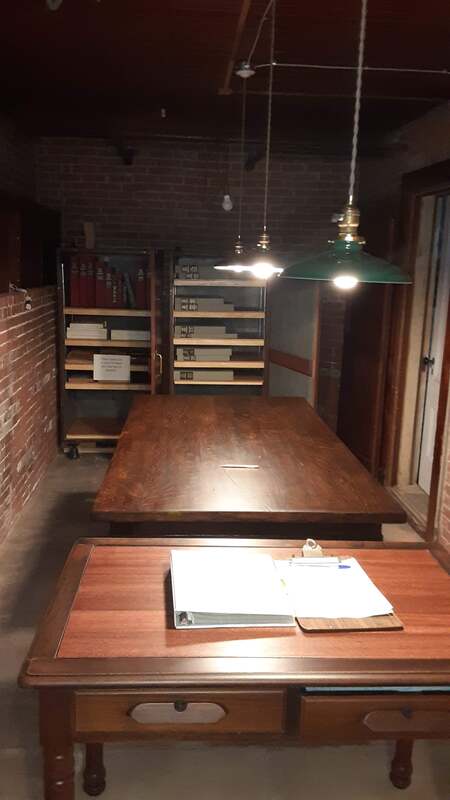Since 2019, we have written four grants on behalf of the French Cable Station Museum. The Orleans Community Preservation Committee has generously funded over $160K worth of projects which will ensure the long term preservation of the museum building and its collection of equipment, photographs and documents dating back to 1898.
This building is one of Orlean's most significant historic landmarks. It is an authentic undersea telegraph station housing one of the world's largest collections of undersea telegraphy equipment. A cable nearly 3200 miles long ran directly from Orleans to Brest, France. The station closed in 1959. A small group of Orleans citizens managed to purchase the station and all of its contents from the French government in 1972. The museum is run entirely by volunteers who provide guided tours during the summer season. The museum recently celebrated the 50th anniversary of it's establishment. Additional volunteers are always needed! Click here to contact Joe Manas, museum President.
This building is one of Orlean's most significant historic landmarks. It is an authentic undersea telegraph station housing one of the world's largest collections of undersea telegraphy equipment. A cable nearly 3200 miles long ran directly from Orleans to Brest, France. The station closed in 1959. A small group of Orleans citizens managed to purchase the station and all of its contents from the French government in 1972. The museum is run entirely by volunteers who provide guided tours during the summer season. The museum recently celebrated the 50th anniversary of it's establishment. Additional volunteers are always needed! Click here to contact Joe Manas, museum President.

The Town of Orleans Community Preservation Committee has provided over $160K to fund much of the work done by us, and other outside contractors from 2019 to 2023. This includes new HVAC systems, updated electrical wiring, window restoration, mold remediation, exterior painting, creation of an online database (with photos of equipment and artifacts), restoration of photographs and documents, and the conversion of a room in the basement into a library for storing and researching the historic documents and more.
You can see the online version of the database here.
Library:
In our review of museum minutes and reports, we came across letters written in 1993 between Laurie Gray (curator) and Ms. Jessie Bell MacDonald (librarian). They shared a concern regarding the long term archival storage of the documents spanning the years from 1898 until 1959 when the station closed. Mr. Gray specifically mentioned the idea of using a room in the basement for a library.
The room he referred to was formerly used to house what was referred to as “the artificial line”. Built before there was such thing as “climate control” the room is enclosed by brick walls, separated from the foundation so as to be insulated from the cold damp earth. The equipment that had been used there was extremely sensitive to variations in temperature and humidity, so the room was kept sealed as tightly as possible. The recent addition of another mini-split has allowed for converting the room into a climate controlled library that will house all of the museum’s historical documents, manuals and books.
An “office in a closet” has been constructed using repurposed doors and cabinets that are actual artifacts of the museum. Behind the doors there is a desk with a computer, printer / scanner, and book shelves. A pair of teak cabinets have been repurposed to safely house the historic documents. In the main part of the room there is a large table, a small desk and good lighting. This provides a comfortable, quiet workspace available year round. Researchers, teachers and students, as well as museum volunteers will have access to the historic materials.
You can see the online version of the database here.
Library:
In our review of museum minutes and reports, we came across letters written in 1993 between Laurie Gray (curator) and Ms. Jessie Bell MacDonald (librarian). They shared a concern regarding the long term archival storage of the documents spanning the years from 1898 until 1959 when the station closed. Mr. Gray specifically mentioned the idea of using a room in the basement for a library.
The room he referred to was formerly used to house what was referred to as “the artificial line”. Built before there was such thing as “climate control” the room is enclosed by brick walls, separated from the foundation so as to be insulated from the cold damp earth. The equipment that had been used there was extremely sensitive to variations in temperature and humidity, so the room was kept sealed as tightly as possible. The recent addition of another mini-split has allowed for converting the room into a climate controlled library that will house all of the museum’s historical documents, manuals and books.
An “office in a closet” has been constructed using repurposed doors and cabinets that are actual artifacts of the museum. Behind the doors there is a desk with a computer, printer / scanner, and book shelves. A pair of teak cabinets have been repurposed to safely house the historic documents. In the main part of the room there is a large table, a small desk and good lighting. This provides a comfortable, quiet workspace available year round. Researchers, teachers and students, as well as museum volunteers will have access to the historic materials.
Please visit : The French Cable Station Museum website





